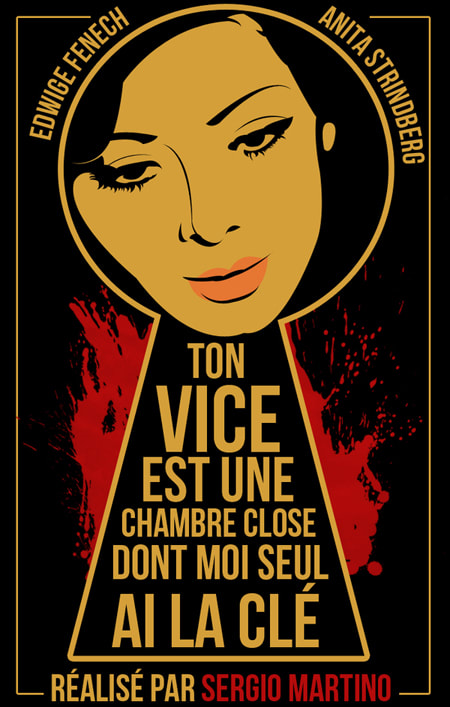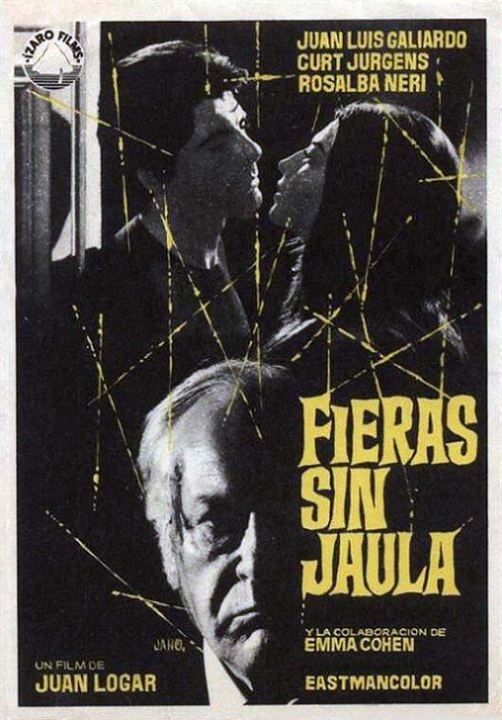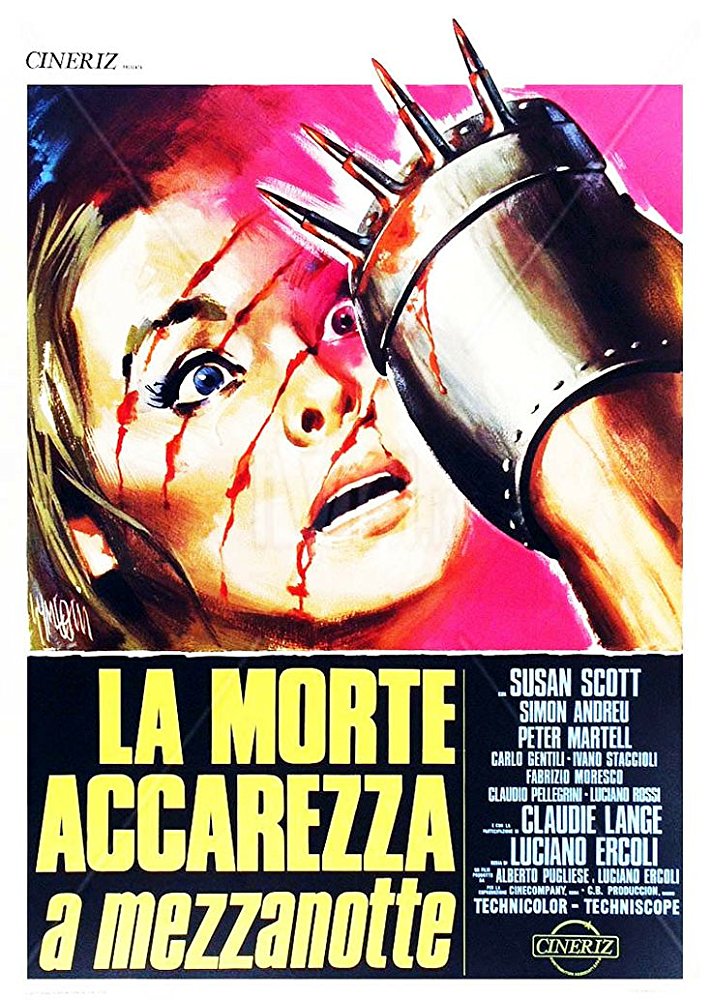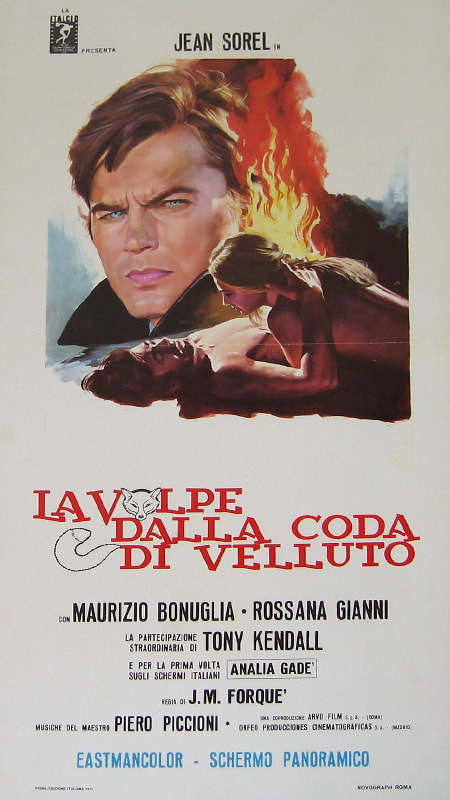My Vice follows Irina and Oliviero, who live in a crumbling mansion which acts as a perfect metaphor for the state of their marriage. When Oliviero's part-time mistress is killed, and then the mansion's housemaid is killed, and then a prostitute with whom Oliviero's arranged a rendez-vous is killed, something seems afoot. The mistress and prozzie killings turn out to have been committed by Michael Sheen, playing the role of a bookshop owner, but the housemaid's murder, which was hushed up by Irina and Oliviero, remains unsolved. Add Oliviero's randy niece Floriana into the mix, along with a healthy dose of unhealthy incest, Ivan Rassimov lurking in the background, along with a seemingly omniscient cat, and you have yourself a prime slice of Gastaldi/Martino pie.
It's not necessarily the tastiest slice, however, but it'll still leave you feeling nicely satisfied. And I'll leave that metaphor there, and move swiftly on. This represents a change of pace from the other Gastaldi/Martino collaborations from the early 70s, apart from maybe All the Colours of the Dark (similarities include Satanism [kinda; it's the name of the cat here], hippie groups and Ivan Rassimov lurking among the scenery). There's no jet-setting, comparatively few characters, and most of the action takes place in and around the aforementioned crumbling castle.
Martino doesn't necessarily use the locations to their best advantage, with the opportunity for a gothic atmosphere evocative of Mario Bava and Antonio Margheriti's best work being largely missed. There are moments of brilliance, though, chiefly when the scene specifically calls for an atmosphere of claustrophobia, which seems to be enough to focus his attention on the task at hand. I'd qualify all this by saying that I heave a sneaking suspicion that Martino was making do with slightly compromised locations, with the references to the crumbling state of the mansion-as well as Oliviero's need to sell off furniture-possibly being a clue to the production's being stuck with a location which they did not have permission to dress. I'll hopefully know more once I've watched the supplemental features on the Blu ray (EDIT: nope!). I can say with certainty, at least, that Martino's fondness for kinetic handheld work is much in evidence here, with his typically brilliantly-precise framing of these shots present and correct.
One area where the film falls short is in its depiction of the hedonistic goings-on within the castle walls. As usual for an Italian 1970s picture, the black character (the maid) is little more than an object of exoticism, and the sex and nudity seems to have a slight 'at-arm's-length' quality, as if the film can't quite commit to revelling in the indulges it depicts. There's a vague sense of fusty displeasure, or judgement, regarding sex which is also evident in other Martino works (eg Torso, and especially his early 1990s thrillers). He certainly doesn't film a lesbian sex scene with the relish of, say, Silvio Amadio. The middle third, in which Edwige Fenech pretty much goes through the cast like a hot, sexy knife through butter, probably played on paper like something from a Radley Metzger film, but the joie-de-vivre of those films is largely lacking on screen here.
Then again, this is a murder-mystery film, not a sex romp. It's not a complete success as a giallo, but there are some decent moments. The murder of the maid, in particular, is a highlight. Daniela Giordano, playing Oliviero's lover, gets a decent death too, albeit one which calls to mind the far superior early kills in Torso. The make-up effects also evoke those in Torso (not a good thing, though). The mystery at the heart of the film is solid, nothing more. It's widely known that this is a (very) loose adaptation of a famous old horror tale, which turns out to be more of a spoiler than I'd anticipated (if you know the basic outline of the Poe story, and bear it in mind when observing the characters' behaviour and utterances, you'll know upon whom to focus your investigative eye), so I won't go into that here.
I will say, though, (slight SPOILERS) that the decision to hide the corpse of one of the principal characters seems bizarre, as the villains seem to be voluntarily creating a situation which evokes Georges Franju's earlier 'Spotlight on a Murderer', a film about the tribulations a greedy family endure when trying to secure the inheritance of a wealthy relative who's disappeared. If a cursory internet search has not lied to me, Italian law imposes a waiting period four times as long as that which the Franju protagonists have to endure before the wealth can be inherited, which makes the decision seem even more mental. So why hide the body, why not just frame someone else for the murder? I'll tell you why, it's because the film is an adaptation of a certain story, as referenced above, and a hidden corpse is thus a requisite. (Slight SPOILERS end.)
One other moment of note comes towards the end, with some mad-person-at-a-typewriter activity which Stephen King and Stanley Kubrick would famously utilise later in The Shining. That's not to say that this film was an inspiration on the latter one; they're both homaging/ripping off Les Diaboliques. The staging of the scene in Your Vice is eerily similar to that in the Shining, though. Plus, it just goes to show how influential the Clouzot film was, and still is on mystery cinema.
In general, this is a qualified success. The decadence and sexuality are dialled down from earlier films like All the Colours, when the story really demands that they be dialled up. There's a rehashing of the secondary, independently-operating killer from The Case of the Scorpion's Tail, although the ultimate identity of the killer does represent something of a departure for the Gastaldi/Martino team. The music here, by Bruno Nicolai, isn't as attention-grabbing as some of the more famous giallo scores, but in terms of complementing-rather than overwhelming-the on-screen action, you'd be hard-pressed to find a better giallo score anywhere. Again, though, you mightn't want the music to occupy a complementary role; you may well want it to drive the action, to overwhelm it, and you. This sums up the film, really; nead and tidy, not loud and brash. In some ways, things had gotten a bit stale for Gastaldi and Martino by this stage (only by their extremely high standards, mind). Not to worry, though, they'd soon be back with a far better example of how to set a film around a single, isolated location, with a special effects make-up budget of a tenner: Torso.




 RSS Feed
RSS Feed
